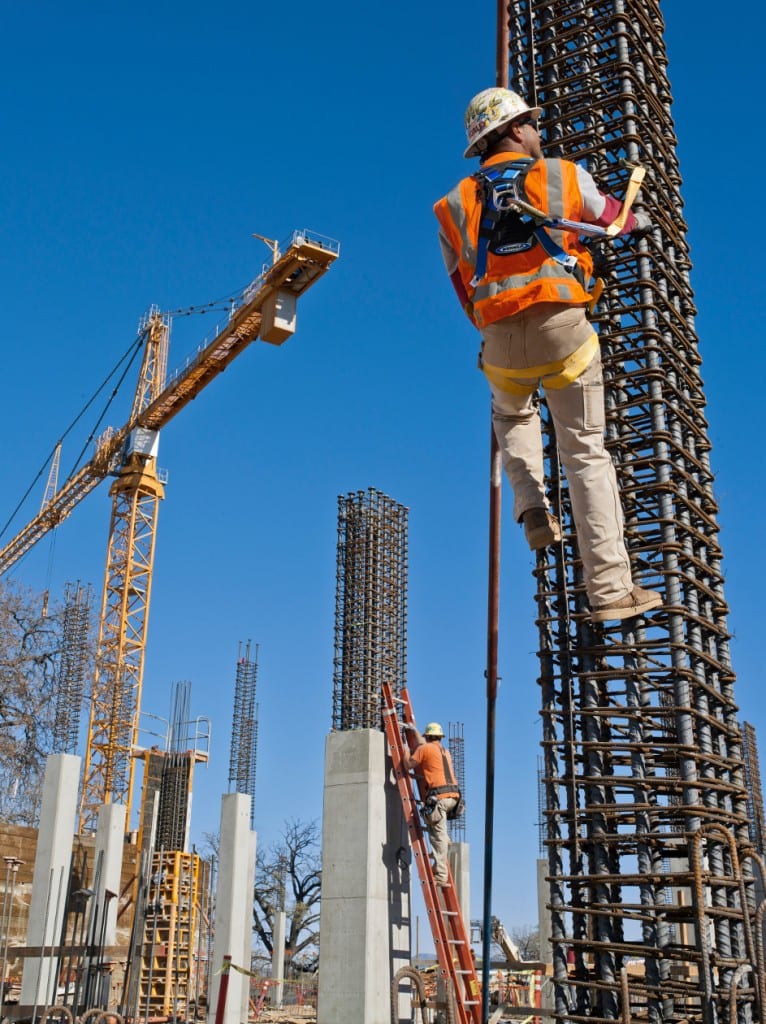Accidents happen, and construction sites are rife with potential dangers. Supervisors, company owners, and employees must work together to minimize hazards as much as possible. Not only will construction safety measures keep your employees safe, but also keep your jobsite moving at optimal levels and prevent downtime. Below are 5 simple, effective ways to improve safety on any construction site.
1. Reach New Heights, The Safe Way
 Although ladders all have a common purpose of keeping you safe when needing to reach high places, you need to know which ladder to use when.
Although ladders all have a common purpose of keeping you safe when needing to reach high places, you need to know which ladder to use when.
- Only use ladders for the duties they were designed and manufactured to perform. For example, metal ladders should never be employed for electrical work or near overhead power lines.
- Ladders should be long enough to allow workers to comfortably complete their duties, without risk. If a ladder is too short or long the worker is at risk of falling.
- Load rating should be sufficient to support the worker and the tools and materials they carry. A lot of times the weight of equipment isn’t taken into real consideration, but all equipment should be weighted and calculated to make sure the ladder can support the job.
- Inspect ladders before each use to make sure they are free from grease, solvents, paint, or other materials that can cause slipping. Immediately remove from service any ladders with broken, cracked, or bent rungs and rails.
2. Protect Against the Fall
By its nature, construction work is hazardous. Much of the work takes place around openings and on roofs and upper floors. This also means that falls are likely to occur, even with proper training and education of the job.
While falls are the leading cause of construction deaths, relatively simple equipment – harnesses, lanyards, guardrails, nets, etc. – can prevent many of them. For these items to be effective, however, contractors must provide the appropriate equipment and insist their workers use it on any job off of the ground. Also proper training of fall protection equipment will ensure workers know which equipment to use to keep them safe.
3. Enhance Your Wardrobe with Personal Protective Equipment
Project managers are responsible for implementing all feasible logistical, scheduling, delivery, and site controls in order to provide a safe workplace. Still, construction workers often must perform many jobs in:
- Confined spaces
- Around hazardous materials,
- Using tools and materials that can cut, fall on, shock, or run into them
- Performing with tools and materials that can irritate their skin, eyes, lungs, and other sensitive areas.
Often taken for granted and easy to discard, personal protective equipment is critical to workers’ safety when other measures cannot fully eliminate hazardous situations. Employers should make clear to employees and subcontractors that failure to wear required hardhats safety glasses, earplugs, respirators, gloves, steel-toed boots and other PPE will not be tolerated.
4. Examine Construction Tools Before Use
Step 1: Keeping hand and power tools in good repair and adequately maintained is the first step in making them safe for employees. Fully examine each tool before it leaves the crib or shop for sharpened blades, uncompromised cords, tight handles, clean grips, and unobstructed switches. If any tool does not work properly, it should be returned immediately.
Step 2: The second step is training construction workers of the hazards associated with each tool and how they can be avoided. Employees should be told they are not allowed to remove or alter any tool guard or other safety device. Also, they must know to use tools only for the job for which they are made.
5. Communication is Key
With excavations and installations, material deliveries, and new trades arriving, construction sites change regularly, presenting new construction safety hazards almost daily. Communicating these potential dangers will make workers aware and provide them information on the proper equipment to use and processes to follow in order to mitigate the risks. Including all workers on the site in toolbox talks and safety meetings eases safety coordination between trades and fosters open communication that can uncover hidden dangers. Make sure a person with the authority to make changes that will improve jobsite safety and oversee their implementation leads the meetings.
Construction Safety Solutions to Minimize Danger and Downtime
Workers, managers, and company owners can work together to minimize the dangers found on construction sites. Following proper procedures in selecting, using, and maintaining equipment protects employees from hazards associated with tool malfunction and breakage. Protective equipment offers a second line of defense when exposure to dangers is unavoidable. And making sure everyone on the jobsite is aware of potentially unsafe situations prepares them to take proper actions to avoid them.
The Pro Group staff is certified in a number of quality safety and product certifications including OSHA standards, ANSI standards, and more. Our team is here to educate you on construction safety products, trends and regulations to help keep you in code and keep your jobsite safe, so that your workers are protected, with no downtime to the job.
Browse our selection of construction products today or contact us to learn more about our safety solutions and training at The Pro Group.



